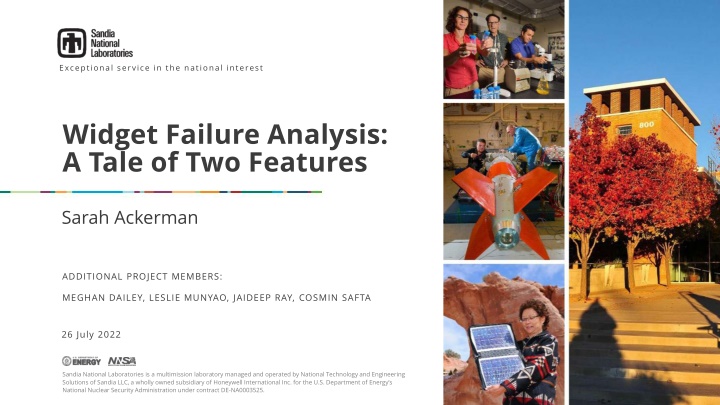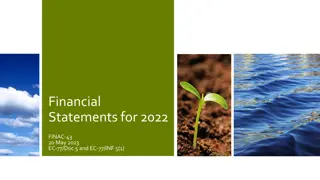
Analysis of Widget Manufacturing Failures at Sandia National Laboratories
"Explore the challenges in identifying and controlling widget failures in a complex manufacturing process at Sandia National Laboratories. Research questions aim to predict failures and improve manufacturing processes proactively."
Download Presentation

Please find below an Image/Link to download the presentation.
The content on the website is provided AS IS for your information and personal use only. It may not be sold, licensed, or shared on other websites without obtaining consent from the author. If you encounter any issues during the download, it is possible that the publisher has removed the file from their server.
You are allowed to download the files provided on this website for personal or commercial use, subject to the condition that they are used lawfully. All files are the property of their respective owners.
The content on the website is provided AS IS for your information and personal use only. It may not be sold, licensed, or shared on other websites without obtaining consent from the author.
E N D
Presentation Transcript
Exceptional service in the national interest Widget Failure Analysis: A Tale of Two Features Sarah Ackerman ADDITIONAL PROJECT MEMBERS: MEGHAN DAILEY, LESLIE MUNYAO, JAIDEEP RAY, COSMIN SAFTA 26 July 2022 Sandia National Laboratories is a multimission laboratory managed and operated by National Technology and Engineering Solutions of Sandia LLC, a wholly owned subsidiary of Honeywell International Inc. for the U.S. Department of Energy s National Nuclear Security Administration under contract DE-NA0003525.
Project Overview Mission and Problem 2
Widget Manufacturing Widgets are manufactured via a highly complex process: Both manual and automated processes Components manufactured at various facilities, where we have varied levels of influence Thousands of measurable states, of which only some are measured Different states measured by different equipment at different facilities Component C WIDGET Widgets suffer from two primary failures: Type 1 failures are easy to identify and catastrophic Type 2 failures happen after repeated stress testing, and occur on a spectrum of Normal to Failed Component B Component A Dataset is: all manufacturing data: no results of destructive testing were included (except as class labels) unbalanced: fewer than 10% of samples are examples of failures wide: ~1500 features and ~6,000 samples 3
Research Questions Project purpose: Are there manufacturing predictors of failures that can be identified and controlled prior to the failure occurring? This is really three questions: 1. Are there manufacturing predictors? 2. Can they be identified? 3. Can they be controlled prior to failure? Asked across multiple class splits: 1. 3-Class: Normal vs. T1 Failure vs. T2 Failure 2. 2-Class: Normal vs. Any Failure 3. 2-Class: T1 vs. T2 Failures 4. 2-Class: T1 vs. Other (Normal + T2) 5. 2-Class: T2 vs. Other (Normal + T1) 4
Answering Question 1 Is this dataset predictive? 5
A Quick Look at the Features Self-correlation of features correlated |corr| > 0.5 with Normal vs Any Failure class split Job Attributes Some label a group of parts moving together through production floor; set of parts encapsulated at same time Some measurements are per-job, not per-part Physical attributes: mass, height, diameter These are all measured separately on fully assembled widgets. Hypothesis: Near-perfect (or perfect) correlation of these measurements with one another may indicate a problem either in measurement or in data recording. Potentially causal One is interesting and may have causal relationship with norm/fail classification. Still: why so tightly correlated (all features here are > 0.84 correlated with one another) with other measurements? Hierarchical Clustering: Dendrogram 6
Clustering Results: k-Nearest Neighbors [1899 8 7 ] [ 19 6 2 ] [ 7 010 ] [ 25 15 ] [ 26 1892 ] [ 46 21 ] [ 0 48 ] 8
Answering Q2 and Q3 Refocus on Type 1 Failures Q2: Can predictors be identified? Q3: Can they be controlled prior to failure? 9
SparsePCA vs. SparserPCA With increased sparsity, clusters are preserved, but dimensionality is reduced. Replicated with Normal + T2 (aka other ) vs. T1 to truly separate T1 failures. 10
Top 20 SparsePCA Features [1906 0] [ 1 24] [2540 0] [ 1 33] RF F1 = 99% k-NN F1 = 99% 11
Top 10 SparsePCA Features [1906 0] [ 1 24] [2540 0] [ 1 33] RF F1 = 99% k-NN F1 = 99% 12
Lets Look at One Tree from the Forest 51 total T1 samples 47 are correctly classified using only two features: 1. A job number 2. A measured physical attribute 13
Random Forest with Two Features F1 = 98% I should have been more suspicious before I reported these results. Remember that hypothesis I had about the correlation study? Hypothesis: Near-perfect (or perfect) correlation of independent physical attributes with one another may indicate a problem either in measurement or in data recording. 14
Summary 2 Features sufficient for Normal vs. T1 Failure classification This relationship is spurious The SMEs knew something was up with our results, but didn t know why We aren t collecting all the data we re supposed to be collecting It is critical that we use explainable, interpretable methods whenever possible TODO: 1. 2. 3. Identify all bogus features in the dataset Remove them and re-analyze the data (for all class splits) Offer recommendations, including data gathering suggestions 16














